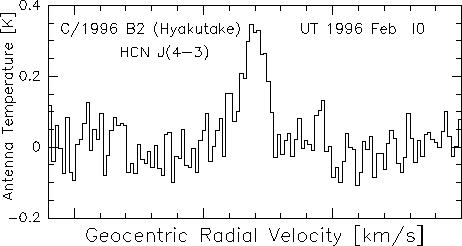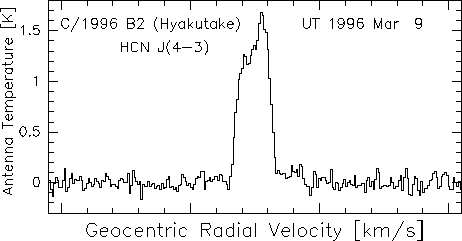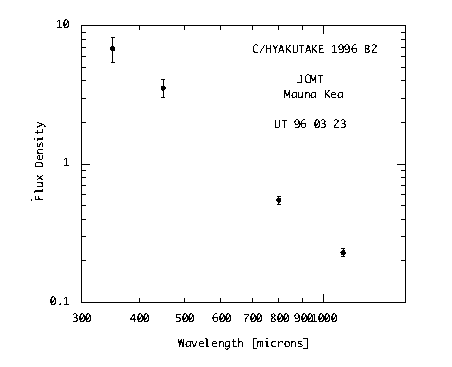
| Hyakutake |
|---|

|
From IAU Circular No. 6335 (March 5 1996)
We report the detection of CO
(3-2) emission from C/1996 B2 at the James Clerk Maxwell Telescope
on Mauna Kea on Mar. 1.54 and 2.52 UT. Observations on Mar. 1.54
showed the line at -57.96 +/- 0.03 km/s, with peak antenna
temperature 0.32 K, area 0.37 +/- 0.02 K km/s, width 1.08 +/- 0.07
km/s, and an ephemeris geocentric radial velocity -57.94 km/s. All
quantities were confirmed on Mar. 2.52. Assuming rotational
temperatures of 30 and 50 K, we estimate log Q(CO) = 28.00 and
28.04, respectively. This compares with log Q(OH) = 28.73 on Mar.
1.5 (IAUC 6333). The implied Q(CO)/Q(OH) = 0.2 is similar to
CO/H2O = 0.15 derived for 1P/Halley (Woods et al. 1986, Nature 324,
436). Available evidence thus points to a comet that is like
1P/Halley both in its absolute gas production and in its CO/OH and
HCN/OH (IAUC 6318) ratios.
M. Senay (UH), H. Matthews (Joint Astron. Ctr, Hilo & Herzberg
Inst. Astrophys, Ottawa), and D. Jewitt (UH).

|
From IAU Circular No. 6318 (February 20 1996)
We report the detection
of HCN (4-3) emission from comet C/1996 B2 at the James Clerk
Maxwell Telescope on Mauna Kea: "Observations on Feb. 10.7 UT show
the line at -58.05 +/- 0.05 km/s, with peak antenna temperature
0.33 K and area 0.40 +/- 0.03 K km/s. The geocentric radial
velocity of the comet was -58.01 km/s. The line width (1.1 +/- 0.1
km/s) indicates expansion of the coma gases at 550 m/s. Assuming a
kinetic temperature of 15 K (30 K), we estimate HCN production
rates log Q(HCN) = 26.26 (25.93). This is comparable to the HCN
production rate in 1P/Halley at 1.65 AU inbound (Schloerb et al.
1987, A.Ap. 187, 475). The ratio of the HCN to OH production rates
(cf. IAUC 6311) is about 0.004. Within the uncertainties due to
modelling and to possible temporal variability, this ratio is
consistent with the value measured in 1P/Halley at perihelion.
H. Matthews, Joint Astronomy Centre, Hilo, and Herzberg
Institute of Astrophysics, National Research Council of Canada;
M. Senay and D. Jewitt (UH).

|
A factor of 5 brightening of the HCN (4-3) line is apparent relative to the JCMT spectrum of 1996 February 10, as well as a change in the line shape. This spectrum was obtained by J. Davies, W. Dent and G. Watt on behalf of the JCMT Hyakutake Target of Opportunity Program.

|
on 1996 Mar 23
We detected continuum emission from C/Hyakutake 1996 B2 using the James Clerk Maxwell Telescope on Mauna Kea. Preliminary estimates of the flux density at 350 (800) micron are 6.8+/-1.3 Jy (0.55+/-0.04 Jy), on both UT 1996 March 23 and 24. These are by far the strongest continuum detections ever achieved in a comet. From these and other measurements we deduce a relatively flat spectral index, -2.9+/-0.1. This is intermediate between the large particle (index = -2) and Rayleigh particle (index = -4) limits, but is compatible with thermal emission from dust grains having a wide range of sizes up to and including millimeter & centimeter sized 'gravel'. It is also typical of the index measured in the dust disks of T Tauri stars, perhaps because these disks consist of particles very similar to those released from comet Hyakutake.
The data were aquired as one part of the JCMT Target of Opportunity program, conducted by:
H.E. Matthews, Herzberg Institute of Astrophysics, Ottawa, and Joint Astronomy Centre, Hilo (JAC), D. Jewitt, M. Senay and T. Owen (UH), J.K. Davies and W.R.F. Dent (JAC), N. Biver, D. Bockelee-Morvan, J. Crovisier, H. Rauer and D. Gautier (Meudon Obs.).
The measurements of the spectrum, together with limited spatial map data not shown here, are to be published in the March 1997 issue of The Astronomical Journal.
| Submillimeter | Jewitt |
|---|
Last Updated February 1997